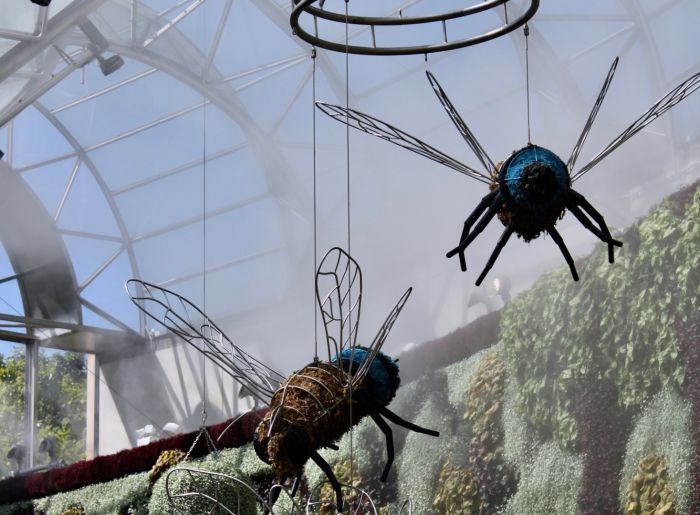For four years I’ve watched the queen in my backyard and never seen her bloom – only ever sighting the bud that heralded she was about to open and the morning wilt that confirmed she had.
This year, I finally caught her in the act – flaunting two beautiful white blooms, luminous and almost translucent, yellow stamens stippled with pollen and emerging from pale throats.
It was exciting to see nature in action and to meditate on its strangeness. I wondered what insect or animal came during the brief hours of the night to collect the pollen – and what happened next. I secretly hoped the pollinator was a bee – because I know they’re under threat.
The queen’s flowering spurred me to head to Pollination at The Calyx at the Royal Botanic Garden Sydney. It’s a free floral display that features a six-metre-high 50-metre-long wall packed with colourful plants and flowers, and which showcases the role colour plays in pollination.
The exhibition reminded me that a pollinator is an animal that moves pollen from the male anther of a flower to the female stigma of a flower – and that they can be insects or vertebrates. It’s this transfer that makes fertilisation possible and fruit, which carries seeds, can develop and lead to the next generation of plants.
Pollination at The Calyx focuses on plants that are pollinated by bees, butterflies, bats, moths and birds. Large topiary bees hover above garden beds of orchids, daisies, gardenias and lilies and beside the “green” wall.
The flowers on display are changed with the seasons by the RBG’s horticulturalists, which means it’s been possible to visit The Calyx numerous times to encounter a different array of scents and floral effects.
If you download the Royal Botanic Garden app, you can also learn more about why we need pollinators. I was intrigued by Australia’s native blue-banded bee, which flies solo and performs “buzz pollination” – shaking to release pollen from inside tight tubes within native plants.
I also learned about the Flow Hive, which was invented by a father and son from the Northern Rivers in NSW, and makes harvesting honey as simple as turning a tap. Funded by one of the most successful Indiegogo crowdfunding campaigns ever, it’s worth a look.
Pollinators key to our future
Pollination is a serious business – pivotal to food production, economic growth and ecological sustainability. Of the 100 crop species that provide 90 per cent of the world’s food, more than 70 are pollinated by bees.

An update about the global decline of bee populations by Australians Simon Klein (a PhD student studying bee cognition and behaviour) and Andrew Barron (an associate professor of biological sciences) was published in The Conversation in May 2017.
“Ten years on from the alarm over disappearing bees, it is fair to say we now know the nature of the problem and what can be done to fix it,” they said.
“It’s up to us to take the steps needed to sustain these precious pollinators of our food for the future.”
Klein and Barron outline a number of simple actions we can take to preserve our bees by improving the environments in which they collect food.
I’d add to their list that The Calyx shop sells wax wraps, which are good substitutes for cling wrap – reusable and very safe.





